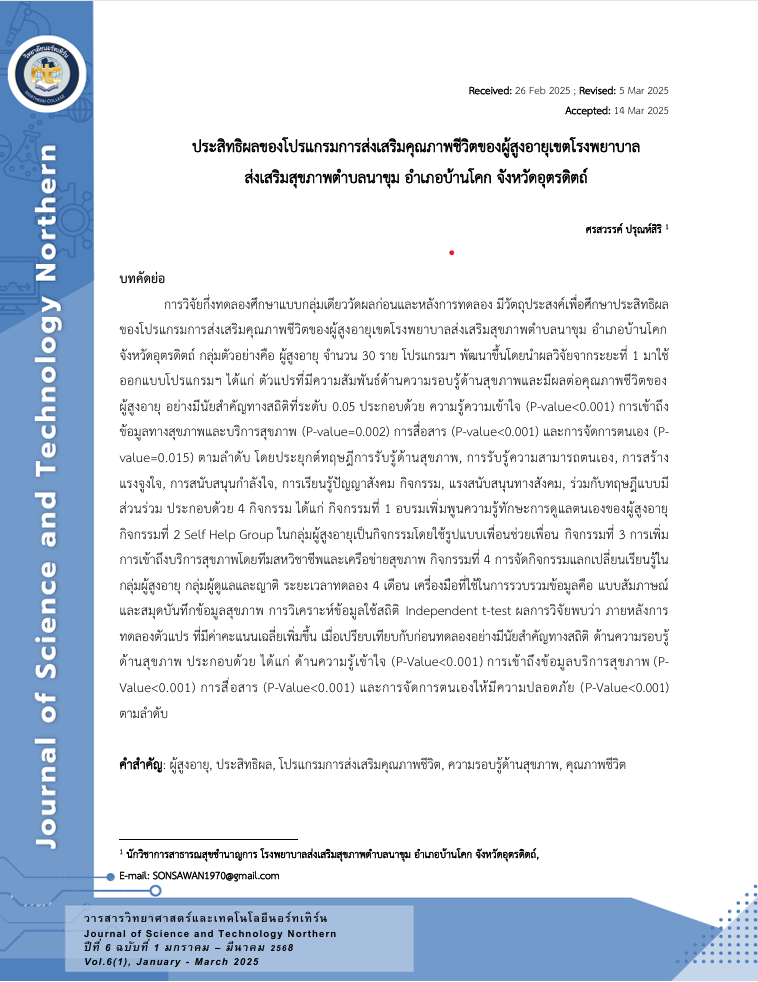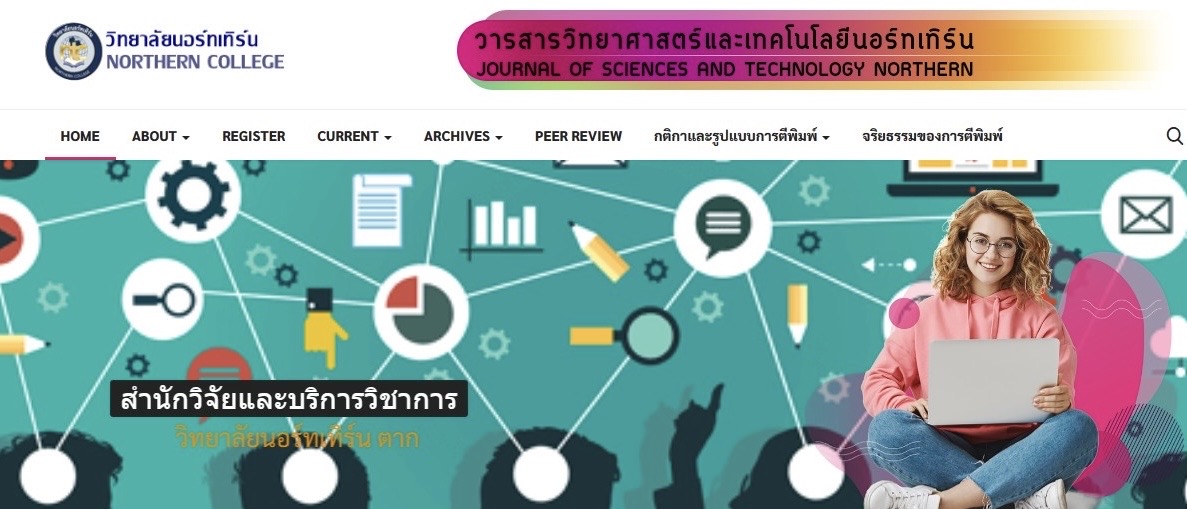Effectiveness of the promoting of quality of life program among elderly in NaKhum Sub-district Health Promoting Hospital, Ban Khok District, Uttaradit Province.
Keywords:
Elderly, Effectiveness, Quality of life promotion program, Health literacy, Quality of lifeAbstract
Abstract
The Quasi-experimental research aimed to study the effectiveness of a program to promote the quality of life of the elderly in the area of Na Khum Subdistrict Health Promotion Hospital, Ban Khok District, Uttaradit Province. The sample size consisted of 30 elderly people. The program was developed by using the research results from Phase 1 to design the program, including variables that were significantly related to health literacy and had an effect on the quality of life of the elderly at a statistical level of 0.05, consisting of knowledge and understanding (P-value<0.001), access to health information and health services (P-value=0.002), communication (P-value<0.001), and self-management (P-value=0.015), respectively, by applying the theory of health perception, self-efficacy perception, motivation, moral support, social intelligence learning activities, and social support, along with participatory theory. It consisted of 4 activities: Activity 1: Training to enhance knowledge and skills in self-care for the elderly; Activity 2: Self-Help Group in the elderly group using the peer-to-peer model; and Activity 3: Increasing access to health services by Multidisciplinary team and health network Activity 4 Organizing knowledge exchange activities among the elderly, caregivers and relatives. The experimental period was 4 months. The tools used to collect data were interview forms and health data records. Data analysis used the Independent t-test. The research results found that after the experiment, the variables with significantly increased mean scores compared to before the experiment were health literacy, including knowledge and understanding (P-Value<0.001), access to health service information (P-Value<0.001), communication (P-Value<0.001), and self-management for safety (P-Value<0.001), respectively.
References
กรมกิจการผู้สูงอายุ คลังความรู้. (2565) เรื่อง สิทธิ์และสวัสดิการผู้สูงอายุ. สืบค้นเมื่อ 18 ธันวาคม
เข้าถึงจาก https://www.dop.go.th/th/know/15/646#:~:text=%E0%B8%9
กรมกิจการผู้สูงอายุ คลังความรู้. (2564) เรื่อง การดูแลผู้สูงอายุ. สืบค้นเมื่อ 22 ธันวาคม 2567.
เข้าถึงจาก https://www.dop.go.th/th/know/15/741
กระทรวงการพัฒนาสังคมและความมั่นคงของมนุษย์ กรมกิจการผู้สูงอายุ. (2565) แผนปฏิบัติราชการ
กรมกิจการผู้สูงอายุ ระยะ 5 ปี (พ.ศ.2566-2570). สืบค้นเมื่อ 18 ธันวาคม 2567.
เข้าถึงจาก https://www.dop.go.th/download/laws/th1714457495-845_0.pdf
กรฐณธัช ปัญญาใส. (2560) ประสิทธิผลของโปรแกรมการสร้างเสริมสุขภาพเพื่อการพัฒนาคุณภาพชีวิต
บนพื้นฐานความต้องการของผู้สูงอายุ. วารสารสาธารณสุขมหาวิทยาลัยบูรพา. 12(2), (1-10).
สืบค้นเมื่อ 26 ธันวาคม 2567. เข้าถึงจาก https://ojs.lib.buu.ac.th/index.php/health/
กองสุขศึกษา. (2565). คู่มือการดำเนินงานสุขศึกษาตำบลจัดการคุณภาพชีวิต และชุมชนรอบรู้
ด้านสุขภาพ. กรมสนับสนุนบริการสุขภาพ. สืบค้นเมื่อ 26 ธันวาคม 2567.
เข้าถึงจาก https://www.thaiphc.net/new2020/uploads/content/document/39
นิสา ปัญญา. (2564). การพัฒนารูปแบบตำบลจัดการคุณภาพชีวิตโดยการมีส่วนร่วมของ
ชุมชนส้มป่อย อำเภอราศีไศล จังหวัดศรีสะเกษ. (วิทยานิพนธ์ปริญญาสาธารณสุขศาสตร์
มหาบัณฑิต). มหาสารคาม: มหาวิทยาลัยมหาสารคาม. สืบค้นเมื่อ 20 ธันวาคม 2567.
เข้าถึงจาก http://202.28.34.124/dspace/bitstream/123456789/1522/1/.
นงนุช เชาวน์ศิลป์. (2563). เอกสารประกอบการสอนรายวิชา การพยาบาลผู้สูงอายุ. มหาวิทยาลัย
ราชภัฎนครปฐม. สืบค้นเมื่อ 22 ธันวาคม 2567.
เข้าถึงจาก https://pws.npru.ac.th/nongnutch/system/sys_article/
ภัทริน สุกาญจนาเศรษฐ์ และคณะ. (2553). การวิเคราะห์ข้อคำถาม ความตรงและความเที่ยงของ
แบบประเมินผลลัพธ์. วารสารไทยเภสัชศาสตร์และวิทยาการสุขภาพ.10(2), 49-58.
มนันญา ภู่แก้ว. (2553). พระราชบัญญัติผู้สูงอายุ พ.ศ.2546. สำนักกฎหมาย. สืบค้นเมื่อ 19
ธันวาคม 2567. เข้าถึงจาก https://www.parliament.go.th/ewtadminewt
โรงพยาบาลนครธน. (2553). ปัญหาของผู้สูงอายุที่พบบ่อย หากปล่อยไว้กระทบคุณภาพชีวิต .
สืบค้นเมื่อ 19 ธันวาคม 2567. เข้าถึงจาก https://www.nakornthon.com/article/
วริยา บุญทอง และคณะ. (2564). ปัจจัยที่เกี่ยวข้องกับพฤติกรรมสุขภาพที่พึงประสงค์ของวัยทำงาน
อายุ15-59 ปี 2564 เขตสุขภาพที่ 6. สืบค้นเมื่อ 19 ธันวาคม 2567.
เข้าถึงจาก https://hpc6.anamai.moph.go.th/th/general-of-3/download/?did=2
แว่นใจ นาคะสุวรรณ. (2563). ประสิทธิผลของโปรแกรมการส่งเสริมสุขภาพต่อคุณภาพชีวิตของ
ผู้สูงอายุในชุมชน. กรุงเทพมหานคร. วิทยาลัยนานาชาติพระนคร มหาวิทยาลัยราชภัฏ
พระนคร. วารสารพยาบาลตำรวจ. 12(1), 171-180.
ศิริวรรณ ริมโพธิ์เงิน. (2564). ผลการพัฒนารูปแบบการสร้างเสริมพฤติกรรมสุขภาพที่พึงประสงค์ของ
ผู้สูงอายุโรงพยาบาลสร้างคอม จังหวัดอุดรธานี. สืบค้นเมื่อ 18 ธันวาคม 2567
เข้าถึงจาก https://backgffice.udpho.org>control>download.
ศรสวรรค์ ปรุณห์สิริ, (2567). ปัจจัยที่มีความสัมพันธ์กับคุณภาพชีวิตของผู้สูงอายุเขตโรงพยาบาลส่งเสริม
สุขภาพตำบลนาขุม อำเภอบ้านโคก จังหวัดอุตรดิตถ์. วารสารวิทยาศาสตร์และเทคโนโลยี
นอร์ทเทิร์น. 5(4), 1-12.
สมชาย สุขสิริเสรีกุล. (2539). หลักการและการประยุกต์ใช้คุณภาพชีวิต. วารสารการวิจัยระบบ
สาธารณสุข. 4(3), 214-215.
สมรัตน์ ขำมา. (2560). พฤติกรรมการดูแลตนเองของผู้ป่วยโรคความดันโลหิตสูง โรงพยาบาล
ส่งเสริมสุขภาพตำบลนางเหล้า อำเภอสทิงพระ จังหวัดสงขลา. วารสารเครือข่าย
วิทยาลัยพยาบาลและการสาธารณสุขภาคใต้, 3(3), (153-162).
สุวัฒน์ มหัตนิรันดร์กุล และวิระวรรณ ตันติพิวัฒนสกุล. (2554). เครื่องชี้วัดคุณภาพชีวิตของ
องค์การอนามัยโลกชุดย่อ ฉบับภาษาไทย. กรมสุขภาพจิต. สืบค้นเมื่อ 18 ธันวาคม
เข้าถึงจาก https://dmh.go.th/test/whoqol/.
สุรชัย ปัญญาพฤทธิ์พงศ์. (2565). เรื่อง ทำอย่างไรให้คุณภาพชีวิตดี. กรมสุขภาพจิต. สืบค้นเมื่อ
ธันวาคม 2567. เข้าถึงจาก https://dmh.go.th/news/view.asp?id=2486
สำนักปลัดกระทรวงสาธารณสุข กองบริหารสาธารณสุข. (2566). แผนปฏิบัติราชการ
แผนการบูรณาการเพื่อการพัฒนาสุขภาพผู้สูงอายุ (พ.ศ.2566-2570). สืบค้นเมื่อ 18
ธันวาคม 2567. เข้าถึงจาก https://phdb.moph.go.th/main/editors/userfiles/file
อังศินันท์ อินทรกำแหง. (2557). การพัฒนาและใช้เครื่องมือประเมินความรอบรู้ด้านสุขภาพ
ของคนไทยวัยผู้ใหญ่ในการปฏิบัติตามหลัก 3อ.2ส. สถาบันวิจัยพฤติกรรมศาสตร์
มหาวิทยาลัยศรีนครินทรวิโรฒ. สืบค้นเมื่อ 19 ธันวาคม 2567. เข้าถึงจาก
http://bsris.swu.ac.th/upload/243362.pdf
อังศินันท์ อินทรกำแหง. (2560). การสร้างและพัฒนาเครื่องมือความรอบรู้ด้านสุขภาพของคนไทย.
กองสนับสนุนบริการสุขภาพ. กระทรวงสาธารณสุข. สืบค้นเมื่อ 19 ธันวาคม 2567.
เข้าถึงจาก http://bsris.swu.ac.th/upload/268335.pdf
อนันต์ มาลารัตน์. (2560). ทฤษฎีและแนวคิดในการเปลี่ยนแปลงพฤติกรรมสุขภาพ.ศูนย์อนามัยที่ 5
สืบค้นเมื่อ 28 ธันวาคม 2567. เข้าถึงจาก https://apps.hpc.go.th/dl/web/upFile/2
อรวรรณ มุงวงษา. (2563). ความหมายของแนวคิดพฤติกรรมสุขภาพ. มหาวิทยาลัยราชภัฏเพชรบุรี.
สืบค้นเมื่อ 30 ธันวาคม 2567. เข้าถึงจาก https://nurse.pbru.ac.th/th/wp-
เอมฤทัย กำเนิด. (2563) ผลของโปรแกรมส่งเสริมพฤฒพลังด้านการมีส่วนร่วมทางสังคมของผู้สูงอายุ.
สืบค้นเมื่อ 30 ธันวาคม 2567. เข้าถึงจาก https://www.hu.ac.th/Conference/confe
Bandura, Albert. (1997). Self – efficacy : The exercise of control. New York : W.H. Freeman.
and company.
Green, L. W., & Kreuter M. (1999). Health Promotion Planning: An Educational And
Enviromental Approch. California: May field publishing.
Gibson, C.H. (1993). A study of empowerment in mother of chronically. Michigan:
Boston College.
House, J. W. (1981). Work stress and social support. Menlo park: Addison-Wesley.
Kemmis,s and McTaggart.R (1988). The action Researnch Planne. (3rded.). Geelong,
Australia: Deaking University Press. Nutbeam, D.(2008). The evolving concept of health literacy. Social Science Medicine.67.2072-
Roger, A., ( 1986 ). Teaching Adults. Milton Keynes : Open University Press.

Downloads
Published
How to Cite
Issue
Section
License

This work is licensed under a Creative Commons Attribution-NonCommercial-NoDerivatives 4.0 International License.






